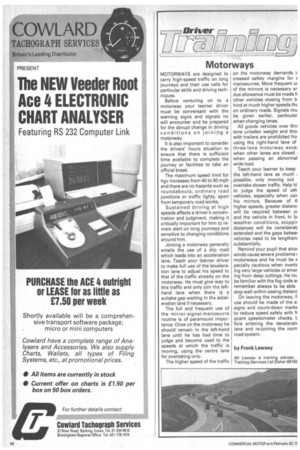Motorways
Page 50

If you've noticed an error in this article please click here to report it so we can fix it.
MOTORWAYS are designed to carry high-speed traffic on long journeys and their use calls for particular skills and driving techniques.
Before venturing on to a motorway your learner driver must be conversant with the warning signs and signals he will encounter and be prepared for the abrupt change in driving conditions on joining a motorway.
It is also important to consider the drivers' hours situation to ensure that there is sufficient time available to complete the journey or facilities to take an official break.
The maximum speed limit for hgv increases from 40 to 60 mph and there are no hazards such as roundabouts, ordinary road junctions or traffic lights, apart from temporary road works.
Sustained driving at high speeds affects a driver's concentration and judgment, making it critically important for him to remain alert on long journeys and sensitive to changing conditions around him.
Joining a motorway generally entails the use of a slip road which leads into an acceleration lane. Teach your learner driver to make full use of the acceleration lane to adjust his speed to that of the traffic already on the motorway. He must give way to this traffic and only join the lefthand lane when there is a suitabe gap waiting in the acteleration lane if necessary.
The full and frequent use of the mirror-signal-manoeuvre routine is of paramount importance. Once on the motorway he should remain in the left-hand lane until he has had time to judge and become used to the speeds at which the traffic is moving, using the centre lane for overtaking only.
The higher speed of the traffic
on the motorway demands ii creased safety margins for E manoeuvres. More frequent u: of the mirrors is necessary ar due allowance must be made fr other vehicles closing from b hind at much higher speeds thE on ordinary roads. Signals mu be given earlier, particular when changing lanes.
All goods vehicles over thrf tons unladen weight and thor with trailers are prohibited fro using the right-hand lane of three-lane motorway excel when other lanes are closed when passing an abnormal wide load.
Teach your learner to keep the left-hand lane as much possible, only moving out overtake slower traffic. Help hi to judge the speed of oth vehicles, especially when usir his mirrors. Because of ti higher speeds, greater distanc, will be required between y( and the vehicle in front. In br weather conditions, stoppir distances will be considerab extended and the gaps betwer vehicles need to be lengthenr substantially.
Remind your pupil that stror winds cause severe problems r motorways and he must be E pecially cautious when overte ing very large vehicles or emer ing from deep cuttings. He mi. be familiar with the fog code al remember always to be able stop well within seeing distanc On leaving the motorway, fl use should be made of the e: signs and count-down mark€ to reduce speed safely with fr quent speedometer checks, fore entering the deceleratil lane and re-joining the norrr road system.
by Frank Lewsey
Mr Lewsey is training adviser, Training Services Ltd (Esher 66185


















































